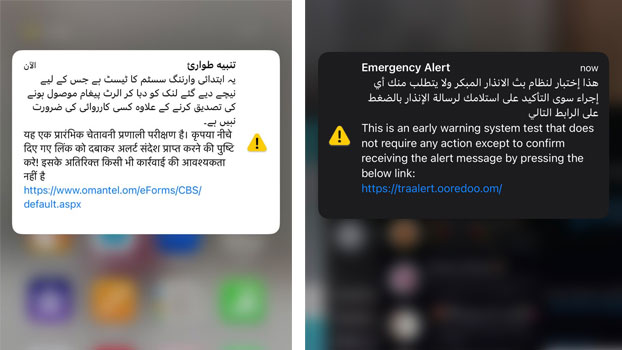

Muscat: An early warning broadcast system aims to warn areas that are at risk or are expected to be, either from natural or industrial disasters, an expert in technical specifications at the Telecommunications Regulatory Authority (TRA), said.
Speaking exclusively to Times of Oman’s radio channel Al Shabiba, Ibrahim bin Hamdan Al-Ma’wali, an expert in technical specifications at the TRA said: “An early warning broadcast service is a new system that has not been used for previous disasters, indicating that the system is currently linked to the Civil Aviation Authority (CAA), which is an authority responsible for monitoring, giving early warnings and providing emergency management, so it can be used now for any dangerous situation, whether natural, such as hurricanes, tsunamis etc., or industrial, such as fires, or for educating the public about the facts of emergency situations as well as responding to rumours in a particular area that is exposed to danger.”
Al-Ma'wali said that the Sultanate of Oman is not immune from dangers, so it is necessary to have an effective system for communicating with the public very quickly. Accordingly, the Authority, in coordination with the CAA and telecommunications companies, has developed a system for broadcasting early alarms via mobile phones. The system sends a text message or warning alert with a distinctive and loud sound that reaches subscribers in a specific area according to the potential danger that may be there.
He pointed out that in light of this, the residents of the region must be informed of the expectation of danger, and they must be informed about it in their region and at the right time.
Among the advantages of the early warning broadcast system, Al-Maawali said that subscribers in the vicinity of the target area at risk can receive the warning message in a timely duration of, for example, five to ten minutes.
Al-Ma’wali stressed that the experiment was to understand the challenges and solve them in the system, as well as to have people’s awareness of the importance of service. The first experiment was in the Wilayat of Al-Musanna on May 3, 2023, after which focus was placed on the wider experiences from the Wilayat to a Governorate, by applying the the system in the governorate of Al Sharqiyah South and Al Wusta yesterday, Monday and Al Wusta. Today, Tuesday, the experiement was conducted at a larger level in the coastal areas in the Governorate of Muscat.
Al-Ma’wali asserted that tomorrow, Wednesday, will be the trial of the regime in Dhofar Governorate.
The technical specifications expert at the Telecommunications Regulatory Authority also confirmed that the idea of the system is not limited to a specific region, and it aims to educate the public about the importance of the system, so that when it is launched in the near future, there will be sufficient awareness of its importance.
Ibrahim Al-Ma’wali indicated that the experiment aims to prepare for any future emergency, as well as to clarify rumours, so that they will not be circulated on social media and that information will be drawn from official sources only.
Al-Ma’wali also confirmed that the experiments target the coastal areas in particular, and the rest of the regions in general, by virtue of the fact that the coastal areas are exposed to many natural disasters such as hurricanes, tsunamis, weather storms, and others.
Ibrahim Al-Ma’wali said that the system currently operates in 4 languages. These are Arabic, English, Hindi and Urdu. Updates can be updated in any language, and subscribers need to constantly update their phone systems to be able to take advantage of the warning system.
Regarding those who received the warning today, Al-Maawali confirmed that there is currently a number of people who did not receive the warning because some did not click the link. Teams are employed to ensure that the warnings have been received.
It is worth mentioning that tropical cyclones are one of the most common natural disasters in the Sultanate, which directly affect the coastal areas extending from Muscat in the north to the southern border with the Republic of Yemen, with exceptional cases extending to the coastal areas overlooking the Sea of Oman.
It is also one of the most dangerous natural disasters, as it is usually accompanied by very fast winds, and growing sea waves, in addition to severe flooding of valleys, which may cause great material and human losses, as was the case in 2007, as a result of the Sultanate’s exposure to Cyclone Gonu. Gonu was recorded as the first cyclone that reached the fifth degree in the Arabian Sea in the past 100 years.
The cyclone caused lots of losses, amounting to about 4 billion dollars, and caused the death of nearly 100 people. Three years later, cyclone Phet which also caused great material losses.
Likewise, the devastating Hurricane Shaheen, which hit Gulf coasts and the coasts of the Sultanate of Oman in particular; On the evening of Friday, October 1, 2021, the cyclone began moving along the coasts overlooking the Sea of Oman on Monday morning, and its passage was accompanied by very heavy rains, which included parts of Muscat, as well as South and North Al Batinah. Tled to the formation of torrents and floods in some areas.
In addition, the rise of the sea waves, and the submersion of coastal areas damaged a lot of public property, houses, roads, and lighting poles, and also left dozens of victims.